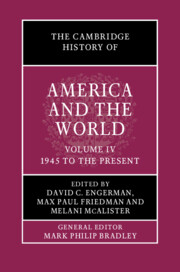Book contents
- The Cambridge History of America and the World
- The Cambridge History of America and the World
- The Cambridge History of America and the World
- Copyright page
- Contents
- Figures
- Maps
- Contributors to Volume IV
- General Introduction: What is America and the World?
- Introduction to Volume IV
- Part I Ordering a World of States
- Part II Challenging a World of States
- 10 US Foreign Policy and the End of Development
- 11 Oil and American Insecurity
- 12 US Mass Culture and Consumption in a Global Context
- 13 Imperial Visions of the World
- 14 Human Rights
- 15 Compassion and Humanitarianism in International Relations
- 16 Third World Internationalism and the Global Color Line
- 17 The Queering of US Geopolitics
- 18 Migration, War, and the Transformation of the US Population
- 19 Christian and Muslim Transnational Networks
- 20 Native Americans, Indigeneity, and US Foreign Policy
- 21 Environment, Climate, and Global Disorder
- 22 Détente and the Reconfiguration of Superpower Relations
- Part III New World Disorder?
- Index
10 - US Foreign Policy and the End of Development
from Part II - Challenging a World of States
Published online by Cambridge University Press: 12 November 2021
- The Cambridge History of America and the World
- The Cambridge History of America and the World
- The Cambridge History of America and the World
- Copyright page
- Contents
- Figures
- Maps
- Contributors to Volume IV
- General Introduction: What is America and the World?
- Introduction to Volume IV
- Part I Ordering a World of States
- Part II Challenging a World of States
- 10 US Foreign Policy and the End of Development
- 11 Oil and American Insecurity
- 12 US Mass Culture and Consumption in a Global Context
- 13 Imperial Visions of the World
- 14 Human Rights
- 15 Compassion and Humanitarianism in International Relations
- 16 Third World Internationalism and the Global Color Line
- 17 The Queering of US Geopolitics
- 18 Migration, War, and the Transformation of the US Population
- 19 Christian and Muslim Transnational Networks
- 20 Native Americans, Indigeneity, and US Foreign Policy
- 21 Environment, Climate, and Global Disorder
- 22 Détente and the Reconfiguration of Superpower Relations
- Part III New World Disorder?
- Index
Summary
For nearly three decades after the end of World War II the US government, across both Republican and Democratic administrations, pursued a foreign aid strategy premised upon the expansion of state capacity to achieve what US scholars, policymakers, and their brethren in industrialized and decolonizing states around the world, called development. The US and other Western governments, philanthropic foundations, multilateral development agencies such as the International Monetary Fund (IMF) and World Bank, self-described “development economists,” and even private corporations broadly agreed that strong states could perform functions that markets performed poorly or not at all. States could build infrastructure, create new institutions of governance and administration, train teachers, scientists, engineers, and bureaucrats, modernize armies and agriculture, engage in varieties of economic and social planning, create social capacity among ordinary people, and pursue strategies for industrialization toward a common modernity.
- Type
- Chapter
- Information
- The Cambridge History of America and the World , pp. 237 - 259Publisher: Cambridge University PressPrint publication year: 2022

